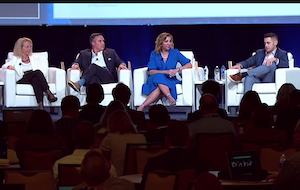 What do the best advisors do that make them the best? A panel of former NAPA presidents shared their “secret sauce” at an April 4 general session at the NAPA 401(k) Summit in Tampa.
What do the best advisors do that make them the best? A panel of former NAPA presidents shared their “secret sauce” at an April 4 general session at the NAPA 401(k) Summit in Tampa.
The insider’s peek into a few of the things the four advisors do was moderated by a fifth NAPA president, Steven Dimitriou of Mayflower Advisors. The panel (left to right in the photo) consisted of:
- Marcy Supovitz of Boulay Donnely & Supovitz Financial Services;
- Paul D’Aiutolo of D’Aiutolo of D’Aiutolo & Malcolm & Associates;
- Pat Wenzel of Merrill Lynch; and
- Alex Assaley of AFS 401(k) Retirement Services.
Here’s a look at some tips from the session.
Prospecting
When it comes to getting new clients, Assaley’s firm “tries to be very active on social media,” he reported, curating content across multiple platforms to share their story and values in the marketplace. In addition, AFS is active with email marketing, networking events—and even cold-calling. In fact, Assaley’s regular schedule includes time set aside every other week to do cold-calling—a reflection of his unusually hands-on approach when it comes to meeting with participants, which he also has done an unusually large amount of throughout his career. “You could argue that a one-on-one with a 23-year-old who just started his first job is not the highest and best use of my time,” he said, “but it’s a great learning experience and a way to stay grounded. It can bring you down to earth a bit from where you thought you were.”
Converting Committee Members into Wealth Management Clients
Pat Wenzel, whose practice encompasses wealth management as well as 401(k)s, shared a novel tip for converting members of plan committees into new wealth management clients. It starts with using recordkeeping data to look up the birth date of every committee member. She then sends each one a personalized “happy birthday” message on their birthday. “Here’s the secret: on Outlook, I go to the section where you put ‘Options: Delay’ and schedule each one,” she said. “I’ve already done all my April emails—last week.”
Wenzel offered an example in which she sent an email to a committee member on her 62nd birthday that closed with: “I noticed that it’s your 62nd birthday. I know you’re not anywhere near thinking about retiring, but if you’d like to sit down and talk about Social Security options and do some more serious retirement income planning, you know I do that too, right?” The upshot: “I got an email back from her saying, ‘Oh my God, I was just thinking about my Social Security options. When can we sit down and talk?’ Well, I do that about 100 or 150 times a month,” Wenzel said.
You can do this with participants as well, she added. “I hope you’re keeping a list of people who attend your participant education meetings. Then have someone on your team dig up how much money they have in the plan and what their birth date is. If they’re over the age of 55 and they have over $100,000 in the plan, guess what? I add them to Salesforce,” she said, “and they go on my birthday list.”
Just Say No
For D’Aiutolo, a game-changing moment in his career came when he learned that saying no is better than saying yes—“saying no to the wrong kind of clients, to the people who wanted to point me in a direction that wasn’t in my best interests,” he explained. It wasn’t an easy thing to learn, he recalls—in fact, it took many years. “But it can be the most powerful thing that you can embrace. And it was the hardest thing that I’ve had to learn,” he said. “Say you’re just starting out. You’re trying to find your way in this world—trying to bring in revenue, trying to take care of your family. Eventually you come to realize that saying no is perhaps the single greatest thing that you can do” to advance your career, he advised.
Sucession/Contingency Planning
For industry veteran Supovitz—who has already retired once and is now contemplating a second retirement—“if there’s any one thing that I look back at and say, ‘if I’d only done that then, I’d be in a better position now,’ it would have to be starting succession planning a lot sooner. For anybody who doesn’t have a clear successor, I would say that it’s never too soon. And it’s not just about retirement, right? There’s contingency planning as well; it’s about the unexpected happening.”
The ideal scenario, Supovitz said, is to have an understudy waiting in the wings. “Well, don’t underestimate the time it takes to do that,” she advised. And the stakes are significantly higher on the wealth management side of the business than on the plan side. On the plan side, those are mostly business-to-business relationships; but on the wealth management side, those are personal relationships. “Who are you going to turn those people over to?” she asked.
Finding the right understudy “is like finding a soulmate,” Supovitz observed. “And a soulmate who has the wherewithal financially to buy into the business. So this is not an easy thing. To anybody who thinks they have a lot of time to prepare for this, I say: start now. Think about finding the right successor.”

